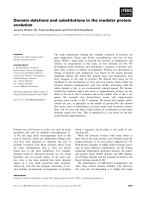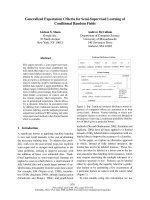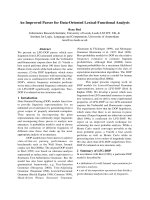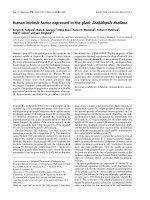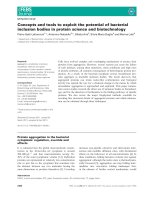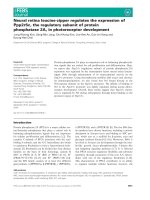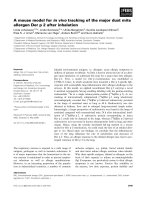Báo cáo khoa học: "Some Psychological Methods for Evaluating the Quality of Translations" doc
Bạn đang xem bản rút gọn của tài liệu. Xem và tải ngay bản đầy đủ của tài liệu tại đây (169.88 KB, 8 trang )
[
Mechanical Translation
, vol.3, no.3, December 1956; pp. 73-80]
Some Psychological Methods
for Evaluating the Quality of Translations
†
George A. Miller and J. G. Beebe-Center, Harvard University, Cambridge, Massachusetts
The excellence of a translation should be measured by the extent to which it pre-
serves the exact meaning of the original. But so long as we have no accepted def-
inition of meaning, much less of exact meaning, it is difficult to use such a meas-
ure. As a practical alternative, therefore, we must search for more modest, yet
better defined, procedures. The present article attempts to survey some of the
possible methods: One can ask the opinion of several competent judges. Or, given
a translation of granted excellence, one can compare test translations with this
criterion by a variety of statistical indices. Or a person who has read only the
translation may be required to answer questions based on the original. The char-
acteristic advantages and disadvantages of each method are illustrated by examples.
ONE HEARS it said that MT is currently rather
crude, but that workers in the field are striv-
ing to improve and refine their translations.
A brief encounter with the unedited output of an
automatic dictionary is sufficient evidence of
the tremendous range of quality between the
simplest mechanical 'translation' and the prod-
uct of a skilled, human translator. The ques-
tion is whether this intuitive judgment of the
quality of a translation can be made more pre-
cise by any psychological techniques of scale
construction.
A scale of the quality of translations should
be reliable, valid, objective and easy to use.
In addition to these general desiderata for all
scaling procedures, there are certain special
features that this particular scale should have.
For example, it should be applicable to any
translation, whether produced by a machine or
by a human translator. This feature would en-
able us to compare the output of a particular
machine to the output of a human who had had a
known number of years of study in the foreign
† Preparation of this paper was supported un-
der Contract AF 33 ( 038 ) — 14343 between the
U.S. Air Force and Harvard University and
appears as Report Number AFCRC —TN—56 —
61, ASTIA Document Number AD 98823. Re-
production for any purpose of the U.S. Govern-
ment is permitted.
We would like to acknowledge the assistance
of Peter Aldin, Martha Taylor, Soon Duk Koh
and Elizabeth Friedman.
language. Furthermore, the scale should be
applicable to translations from or into any lan-
guage whatsoever, and so should not take ad-
vantage of any characteristics peculiar to a
given language, say English — Whether or not a
single scale can apply to all languages and still
make linguistic sense is a debatable question.
And, preferably, the scale should be unidi-
mensional, so that different translations could
be compared with respect to a single 'figure of
merit'. Finally, we would like to have one or
more cutoff points indicated along the scale;
"completely unusable," "useful for scanning as
to subject matter", "useful after post-editing",
"immediately readable, " and "suitable for pub-
lication" are some criteria that we might hope
to locate along the scale.
All these features would be desirable, but
it is not obvious at present that they can be
achieved.
Subjective Scaling
Perhaps the most direct approach is to give
both the original passage and the translation to
be tested to a person who understands both
languages and to ask him to assign a number
between 0 and 100 to the translation, where 0
means that it is equivalent to no translation at
all and 100 means the best imaginable transla-
tion. This method fails the criterion of objec-
tivity, of course, and cannot be applied when a
polyglot is not available to judge, but we ex-
pected to be able to map out the general terri-
tory in this way and to use subjective ratings
74
Miller and Beebe-Center
as a criterion against which to test various
other scaling techniques.
In a short exploratory study, however, we ob-
tained somewhat confusing results. We found
much disagreement among different raters.
Perhaps we should have used foreign language
teachers as our judges, for they probably have
skill in grading that ordinary, bilingual persons
do not seem to have, but we did not anticipate
that the ratings would be so difficult.
For the purposes of this study, we selected
four summaries of articles from the journal
Acustica, two in German and two in French.
The journal also gave an English translation,
so we had the work of a theoretically compe-
tent translator to use for comparison. (The
published translations were not the best pos-
sible, but they represent the sort of thing that
is available in the current scientific literature.)
Then we prepared mechanical translations,
simulating by hand the possible operation of an
automatic dictionary. Each word of the origi-
nal text was written on a card. These cards
were then alphabetized, and on the reverse
side we listed the possible English equivalents
in approximately the order of their frequency
of occurrence, as well as we could judge it on
intuitive grounds. From this pack we then con-
structed six different translations: (1) the
first English alternative was chosen from each
card; (2) an editor selected the best of the
first two alternatives from each card, making
his selection in complete ignorance of the other
alternatives or the original passage; (3) an
editor selected the best one from all the alter-
natives on each card, still in complete igno-
rance of the original passage; (4) an editor
rewrote the English passage from a knowledge
of only the first alternative on each card; (5)
an editor rewrote the English passage from a
knowledge of only the first two alternatives on
each card; and (6) an editor rewrote the Eng-
lish passage from a knowledge of all the alter-
natives on each card, but without seeing the
original passage. In all cases, these editors
were monolingual Americans with no linguistic
training. The first three procedures did not
lead to grammatical English, of course, so we
obtained a fairly wide range of quality by these
procedures. These six translations, together
with the translation taken from the journal and
the original passage, were presented to judges
who rated them on a scale from 0 to 100.
As a sample of the sort of materials pro-
duced, consider a single sentence taken from a
French passage:
Original. Il résulte de ceci qu'une atmos-
phère stratifiée doit toujours réfléchir et
donc produire des échos.
(1) He result of this which a atmosphere
stratified must always to think and there-
fore to produce of the echoes.
(2) It results from this which a atmosphere
stratified must always to reflect and
therefore to produce of the echoes.
(3) It results from this that a atmosphere
stratified must always reflect and there-
fore produce echoes.
(4) The result of this is that in a stratified
atmosphere, one must always think of the
echoes that are produced.
(5) It results from this that a stratified at-
mosphere must always reflect and there-
fore produce echoes.
(6) It results from this that a stratified at-
mosphere always reflects and therefore
always produces echoes.
Published translation. It follows from this
that a stratified atmosphere should reflect
sound and produce echoes under all cir-
cumstances.
A similar sample taken from one of the Ger-
man passages is the following:
Original. Bei beliebiger Impulsform ergibt
sich das Faltungsprodukt aus Membran-
und Impulsform.
(1) By any form of the impulse yields -self
the products of the folding out membrane-
and form of the impulse.
(2) By any form of the impulse yields the
products of the folding out membrane-
and form of an impulse.
(3) By any form of the impulse yields the
products of the folding out membrane-
and form of an impulse.
(4) Any form of the impulse is yielded by the
interaction of the bending out of the mem-
brane and the form of the impulse.
(5) The impulse in any form yields the prod-
ucts of the folding-out membrane and the
form of an impulse.
(6) Any form of the impulse yields the prod-
ucts of the membrane-folding.
Published translation. With a given impulse
form one obtains a resultant effect of the
shapes of the impulse and of the disk.
Evaluating Translations
75
Table I
Mean Ratings of Quality of Seven Translations
Method of French French. French
German
German
German
Translation I II Mean
I
II
Mean
(1)
21.9 28.2 25.1
27.1
22.2
24.7
(2)
35.5 30.1 32.8
21.6
37.0
29.3
(3)
47.3 27.7 37.5
13.3
29.0
21.2
(4)
38.2 70.1 54.2
45.6
31.8
38.7
(5)
90.5 80.4 85.5
24.0
34.0
29.0
(6)
75.9 54.3 65.1
45.5
77.5
61.5
Published 89.5 80.1 84.8 77.0 75.5 76.3
Translation
When the seven translations were given to
subjects to judge, of course, no information
was supplied as to the method of translation.
It is interesting to note that supplying several
alternative English equivalents seems to be
more useful in translating from French than
from German, but this judgment is based
upon only these four samples of about 75 words
each.
Eleven judges were used for the French pas-
sages and ten for the German. The judges
were able to speak the language from which the
translations came, but had no linguistic train-
ing; they were instructed to compare each
translation with the original and to take time
enough to be sure of their judgments. The
means of their ratings are summarized in
Table I.
There was so much disagreement among the
judges (which was reflected in their bitter
comments about the difficulty of their task)
that even the means reveal only very general
trends. These trends are clearer if we pool
the data further, as in Table II.
From Table II we see that far more success
is possible with French than with German, and
that selective editing helps a little but not so
much as complete rewriting. These conclu-
sions are intuitively correct, and it would be
disappointing indeed if they failed to appear.
The error variance is so large, however, that
these conclusions are barely significant.
We were slightly surprised that rewriting
made as much difference as it did, since the
people who rewrote had essentially the same
information about the original passage as was
contained in the selectively edited translations.
The superiority of the rewritten translations
indicated that the judges relied rather heavily
upon the grammaticalness of the translation in
reaching their decisions. In order to check
this notion, we asked another group of subjects
to act as judges, giving them the same instruc-
tions as before except that they were not shown
the original French or German passages.
Their ratings correlated closely with the orig-
inal ratings, especially for the translations
from German. It seems, therefore, that
people will not regard favorably an ungram-
matical translation even though they are able
to understand it correctly.
Table II
Mean Ratings for Three MT Procedures
for French and German
Method
French
German
No editing
(1)
25.1
24.7
Selective editing
(2-3)
35.2
25.3
Rewriting
(4-6)
68.3
43.1
Means
53.4
38.6
76 Miller and Beebe-Center
We can conclude that a simple word-for-
word substitution, method (1), is not satis-
factory, but that an automatic dictionary com-
bined with rewriting is a fairly satisfactory
solution for translating from French into Eng-
lish. The problems with German are more
difficult and seem to require that the machine
recognize syntactic features. These conclu-
sions, however, are of less immediate impor-
tance to us than the conclusions we can draw
about this method of estimating the quality of
translations:
(a)
The method is subjective;
(b) Raters dislike the task; (c) There is con-
siderable error variance, so that many judges
are needed in order to obtain reliable means;
(d) The literary skill of the rewriter is an
important factor in the ratings; (e) An at-
tempt should be made to obtain more experi-
enced judges — either language teachers or
professional translators.
Word Scores
Another way to approach the problem is to
consider what a grader does when he evaluates
a pupil's translation. Introspective reports in-
dicate that he looks for two kinds of errors:
(1) errors in vocabulary and (2) errors in
construction. It is difficult to make these in-
trospections more precise, for vocabulary and
syntax are complexly intertwined. Neverthe-
less, it seems worthwhile to try.
The fact that a grader can recognize errors
at all implies that he must have some personal
standard against which he compares the stu-
dent's work. In its most rigid form, this
might consist of his own written translation;
more often it is probably a rather vague set of
translations that would be about equally accept-
able. In order to imitate his procedures,
therefore, we should have one or more explicit
translations, written out in advance, that we
will use as criteria. The task is then to obtain
some objective measure of the relation be-
tween the test translation and the criteria.
Given a test and a criterion translation, the
simplest thing to try first is to ask if they use
the same words. That is to say, a score can
be given by taking the number of words in the
test translation which are duplicates of words
in the criterion translation and then expressing
this number as a fraction of the total number
of words in the criterion translation. This
method ignores the order in which the words
are written. As an illustration:
Original: La maison se trouve à droite.
Criterion: The house is on the right.
Test:
The house leans to the right.
From the criterion translation an alphabetical
check list of words is prepared and the words
in the test translation are checked against it:
house
1 √
is
1
on
1
Score = 4/6 = 0.67
right
1 √
the
2 √√
A number of exploratory experiments have
been conducted with this method, using trans-
lations produced by students attempting to pass
their language examinations in French or Ger-
man and by competent translators. These
studies have explored various possibilities,
but none of them has been followed up with
large amounts of data. Disregarding levels of
significance, the studies can be summarized
as follows:
(1) Five subjects with a good knowledge of
both languages translated a sentence from Ger-
man into English. These translations, all as-
sumed subjectively to be 'good', were evalu-
ated against a criterion translation. The
scores ranged from 0. 73 to 0. 86. With stu-
dents whose knowledge of German ranged from
low to high, scores ranged from 0.19 to 0.70.
For three persons with little knowledge of Ger-
man, the mean score was 0.31. Four persons
with a relatively good knowledge of German
had a mean score of 0.65.
(2) One passage was translated from French
into English by a simple word-for-word sub-
stitution, taking the first English equivalent
that occurred in a French-English dictionary.
The score for this translation was 0.40.
(3) One person who knew no Turkish but
was familiar with the general subject matter
translated a short, technical passage from
Turkish into English. No dictionary was used.
The score for a language as little related to
English as this was 0.20. The fact that the
score was not zero is due to the occurrence of
common words in the two languages.
(4) In order to study the variability of the
score, eleven French sentences were trans-
lated with a mean score of 0.65. The standard
deviation was found to be 0.12.
Evaluating Translations 77
(5) Seven translations of two German sen-
tences were made by students. These were
scored and the scores were compared with
scores given by a grader on a longer passage
containing these same sentences and also with
scores on an 'objective test' of German lan-
guage ability and achievement. The three
measures of the students' ability were in close
agreement.
(6) Since the use of a particular criterion
translation may seem rather arbitrary, the
check lists from six different criterion trans-
lations were combined and used to score the
students' translations. With one criterion
translation, there was a ceiling of about 0.86
and a mean of 0.50. When six criterion trans-
lations were combined, the ceiling rose to
about 0.95 and the mean increased to 0.58. No
significant changes in the rank order of the test
translations resulted from this broader defini-
tion of the scoring criterion.
(7) When successive pairs of words, instead
of individual words, were used to construct the
check list, the scores were lower but were
linearly related to the scores for individual
words. With sequences of three successive
words used to construct the check list, scores
were very low and discrimination appeared to
be lost.
(8) A word-for-word substitution of Korean
equivalents for English words was made with
ten sentences totalling 171 words in length.
The Korean words, in the English order, were
given to three Korean students at Harvard.
They were asked to rewrite the sentences in
Korean, ignoring as best they could their
knowledge of English. Their rewritten sen-
tences were then scored against a criterion
prepared by an experienced translator. The
three scores averaged 0.49. However, if dif-
ferences in inflection are ignored and the word
is considered correct if the root is identical,
the average was 0.75. It is very likely, how-
ever, that the subjects' familiarity with Eng-
lish was a considerable aid to them.
(9) These same sentences were then trans-
lated again, this time using some simple rules
for pre-editing the English. (a) Articles were
omitted; (b) Idioms were underlined; (c)
When 'of' occurred in a possessive phrase, the
order of the words was inverted; and (d) When
'to' occurred in an infinitive construction, it
was indicated. With this pre-editing, the word-
for-word translation was repeated. The two
sets of sentences, translated with and without
pre-editing, were given to two groups of 31
students each in the Kyung-Bock High School,
Seoul, Korea, and they were asked to rewrite
them into intelligible Korean sentences. Their
sentences were then scored against the crite-
rion translation. The average score without
pre-editing was 0.125; with pre-editing, 0.218.
These scores are probably too low; the stu-
dents were being given instruction during the
summer vacation because of their poor school
records.
These studies support some general com-
ments. For human translators, a simple
measure of correspondence of vocabulary cor-
relates rather well with a subjective evaluation
of the quality of the translation; a student who
has achieved a given level of competence in vo-
cabulary has probably achieved a correspond-
ing level of competence in grammar, so the
vocabulary measure will be correlated with
any other measure of quality. For MT, how-
ever, the correspondence is not so close. It is
possible to imagine a mechanical translation
that is completely unintelligible yet contains
most of the correct words. That is to say, the
vocabulary measure is necessary but not suffi-
cient. Nevertheless, we have been pleasantly
surprised that so mechanical and simple a pro-
cedure gives us any discrimination at all.
Word-Order Scores
In order to supplement the simple vocabulary
score, we would like to have some indicant of
the syntactical adequacy of the translation.
Before bringing to bear the more sophisticated
concepts of modern linguistics, we decided to
try the simplest possible comparison with a
criterion translation. The simplest method we
could think of was to compare the order of the
words which were common to the test and the
criterion translations. For example:
Criterion: The young boy walked fast.
Test:
The fast boy had walked.
From the criterion translation a check list is
again prepared, but this time the ordinal posi-
tion of each word is indicated:
Position in Position in
Criterion
Test
boy
3
3 √
fast
5
2
the
1
1 √
walked
4
5 √
young
2
78 Miller and Beebe-Center
The word score is 4/5 = 0.80, when scored as
before. If we consider the four shared words,
we find that the three checked words corre-
spond as to order. Thus the word-order score
can be stated as 3/4 = 0.75.
Thirteen people, whose knowledge of French
varied from low to high, were given four 300-
word French passages to translate. These
translations were scored by the word-order
method and also by a more subjective tech-
nique, with a grader scoring errors in words
and in phrases. Furthermore, each person
took two forms of an objective examination in
French language achievement.
The word-order scores ranged from 0.20 to
0.72. The error scores given by the grader
ranged from 1.6 to 24.4. The objective exam-
ination scores ranged from 252 to 750 ( where
250 is chance performance). Thus all three
measures discriminated among the translators.
The average correlation between word-order
scores and error scores was about 0.70, and
between the word-order scores and the objec-
tive examination scores was about 0.60.
The reliability of the word-order score is
reasonably good and could probably be im-
proved by lengthening the passages. The cor-
relation with error scores and objective exam-
inations provides evidence for some degree of
validity, at least for human translators. This
technique is useful to discriminate against very
poor translations, but the present evidence in-
dicates that it may not discriminate accurately
in the range that might be labelled 'good' to
'excellent'.
A slightly more sophisticated and less me-
chanical way to get at the syntactic aspects has
been used by Koh in the Korean studies. A
scoring key is constructed in advance by noting
which words modify other words in the origi-
nal English passage. If the rewritten Korean
translation contains this same relation, one
point is given. When the rewritten translations
produced by the Korean high school students
were scored by such a key, they obtained an
average score of 8.5% on the passages without
pre-editing and 23. 3% with pre-editing. The
method is rather arbitrary, inasmuch as the
experimenter must select in advance those
syntactic relations for which credit will be
given, and it is less mechanical than the word-
order score, since it requires some intelligent
judgment both in constructing the key and in
doing the scoring. Nevertheless, it is a tech-
nique that deserves further exploration.
These methods involving a statistical com-
parison of the test translation with a criterion
translation are certainly effective at the lower
end of the scale. Whether the statistical net
can be woven fine enough to catch the subtle
shades of meaning that differentiate between
'acceptable' and 'good' or 'excellent', however,
is still an open question.
Measures of Transmitted Information
One goal, although an unrealistic one, that
we might hope to attain in translation is re-
versibility. That is to say, we could recover
the original passage exactly by translating
back again. We do not usually aspire to this
goal, because it is not necessary to recover
exactly the original passage. Various alterna-
tive wordings may be adequate for purposes of
communication; so we hope merely to land
somewhere inside this set of acceptable alter-
natives. When we translate we hope that some-
thing will remain invariant under translation.
This something might be called the meaning or
it might be called the information. Since tech-
niques for estimating amounts of information
have been developed, this line of thought leads
to the suggestion that we should attempt to
compare different translations to see how
much information they have in common.
The method we have explored is one devel-
oped by Claude Shannon for estimating the re-
dundancy of printed texts. Subjects guess re-
peatedly at successive letters, advancing to
letter n + 1 after they have correctly guessed
letter n. Shannon has shown how to estimate
the amount of information, in bits per letter,
from the frequency distribution of correct re-
sponses on the first, second, third, etc.,
guess. In fact, Miller and Friedman
2
have
found that it is not necessary to obtain repeated
guesses, since the amount of information per
letter can be estimated rather closely from the
percentage of times the first guess is correct.
The relation is H = 5Q, where H is the number
of bits per letter, and Q is the probability of
being wrong on the first guess.
1.
Shannon, C.E., "Prediction and Entropy of
Printed English", Bell Syst. Tech. J. 1951,
30, 50-64.
2.
Miller, G.A., and Friedman, E.A., "The
Reconstruction of Mutilated English Texts",
Information and Control, 1957 (in press).
Evaluating Translations 79
The strategy we have used involves an ap-
proximation to the information formula,
T = H(x) - H
y
(x),
where T is the amount of information common
to x and y; H (x) is the amount of information
in x; and H
y
(x) is the amount of information
in x when y is known. Now suppose that x and
y are two alternative translations of the same
passage. We can estimate H(x) by asking a
subject to guess successive letters according
to Shannon's technique. Then we can take an-
other subject and show him translation y; with
y available to him, he now proceeds to guess
successive letters in x, and so gives us an es-
timate of H
y
(x ). Assuming the two subjects to
have identical guessing habits, the difference
between these two measures should give us an
estimate of the amount of information common
to the two translations. If one translation is a
criterion translation, the value of T should be
high when the test translation contains essen-
tially the same information, and low when it
contains relatively little of the same informa-
tion as the criterion.
In a preliminary study we found that T aver-
aged 0.8 bits per letter for two 'good' transla-
tions of a given sentence and 0.05 bits per let-
ter for one 'good' and one 'poor* translation.
Although these results indicate that the method
may be feasible, it is laborious and time-con-
suming; we have not explored a wide variety of
conditions in this way and will probably not do
so unless it becomes of some further theoret-
ical interest. It does have the slight advantage
that the measure is given in bits per letter,
which may be more meaningful to computer
designers than some more arbitrary scale.
Reading Comprehension Tests
A possible criticism of the methods discussed
so far is that they are too much concerned with
the small details of a translation and too little
concerned with the general purpose of making
translations in the first place. The purpose,
of course, is communication. The translation
should be judged successful if this purpose is
achieved.
In ordinary situations outside the psycholo-
gist's laboratory, we have a simple check on
whether we have communicated successfully.
We ask questions. For example, after a series
of communicative acts that he calls 'lectures',
a teacher will evaluate his success by a proce-
dure that he calls an 'examination'. If the re-
cipients of a message can answer correctly
questions which they could not answer before
they received the message, we conclude that
the communication was successful.
One way to apply this technique is in the form
of commands that must be carried out by some
gross, bodily behavior. A more convenient
way is to ask questions that can be answered
verbally. For example, in order to evaluate
the readability of a particular passage, psy-
chologists give the reader a few minutes to
study it and then ask him a series of questions
ranging from very simple to very difficult.
Once a set of passages has been standardized
for readability on a large sample of readers,
it can be used to measure the reading skill of
other individuals. Such a set of passages with
related questions is called a 'reading compre-
hension test'. It should be relatively straight-
forward to apply this same technique to meas-
ure the comprehensibility of a translation.
The translation to be tested would be pre-
sented to a person along with a list of questions
that he must answer about the meaning of the
passage. These questions should be simple
enough that an intelligent person equipped with
a good translation could answer them all, yet
difficult enough that a person with no transla-
tion could not answer any of them. We have
hesitated to adopt this approach because the
phrasing of the questions requires much skill
and the test should be standardized on rela-
tively large groups of subjects.
For example, the subject might be presented
with the following word-for-word translation of
a German passage:
The theory the passage of sound through
plates is — for even waves and bounded
bundle — in such form given that the rela-
tion with it the free waves of the plate in
appearance steps. Cremer's conception
the total number of passages as 'coinci-
dences' the falling in wave with it free
waves of the plate, certain exceptions
hereof and the influence a final cross
section of the wave are discusses. The
conclusions are experimental with it
ultra-sound on aluminum plate proven.
Then he would be confronted by questions like
the following:
1.
What does the form of the theory reveal?
2.
What was done with the conclusions?
3.
What kind of incident sound was studied
analytically?
80
Miller and Beebe-Center
4.
What kind of incident sound was studied
experimentally?
5.
Was Cremer's theory accepted without
qualification?
6.
What did Cremer think was coinciding?
Although these questions have not been tested
in any way, it is hoped that they will be diffi-
cult to answer until you have read the following
alternative translation:
The theory of transmission of sound —
plane waves and laterally bounded beams —
through plates is given in a form which
reveals the connection with the free waves
in plates. Cremer's interpretation of total
transmission as 'coincidence' of the inci-
dent wave with a free wave in the plate,
certain exceptions from that representa-
tion, and the influence of the finite cross
section of the beam are discussed. The
conclusions have been examined experi-
mentally on aluminum plates by ultrasonic
waves.
This example should make clear the difficul-
ties involved in formulating good questions.
On the one hand, they should not be so specific
as to require a particular word in answer, for
this reduces to a vocabulary test. On the other
hand they should not be so general that it is
difficult to decide whether the answer is right
or wrong. No doubt special passages would
have to be constructed for the purpose; we
have not yet undertaken this formidable task.
Syntactic Analyses
All of the scaling procedures discussed above
are linguistically naive. We have been much
impressed by the elegance of certain theories
of grammar. For example, Z. Harris' con-
stituent analysis should certainly yield some
kind of measure of agreement between the true
analysis and the constituents of the translation
to be tested. However, these ideas have been
difficult to apply because the translations pro-
duced by some of the simpler mechanical pro-
cedures are so bad that it is impossible to say
what the constituents are. Such analysis is
easier if the translation is grammatical.
Ideas concerning the degree of grammatical-
ness of a passage are suggested in the work of
A. N. Chomsky. For example, if words are
classified into syntactic categories, we might
ask how often ungrammatical sequences of cat-
egories occur. As a variable we could examine
the degree of precision of the syntactic classi-
fication. A very grammatical translation would
have only permissible sequences even with the
most refined analysis of categories, whereas
an ungrammatical translation might not have
only permissible sequences until the catego-
ries were reduced to something as crude as
Noun, Verb, Adjective, and X, where X repre-
sents everything else. This is a forbidding
task to undertake, however, and does not get
at the question of whether the translation,
grammatical or not, carries the same meaning
as the original. Indeed, much syntactic analy-
sis carefully avoids any contamination with
semantics.
We have assumed, therefore, that such anal-
yses are much more important for workers
trying to develop translating machines than for
those who would like to evaluate the finished
product.
Our studies have not explored the closely re-
lated problem of measuring the "translata-
bility" of the original passages. We have ob-
served, of course, that with respect to English,
French is more translatable than German. But
there are many other differences. The litera-
ture in any given language is not uniformly
translatable, and some schemes for MT may
succeed with one author and fail with another.
For example, a passage which is well written
in the original language will usually be more
translatable than a poorly written passage. Or,
again, a passage written by a person who
knows no English will usually be harder to
translate into English than something written
in the same language by a person whose first
language was English. Only a large sample of
different materials in the source language can
inform us on this question, and it is imprac-
tical to generate such a sample by manual
simulation. Thus there are important aspects
of the evaluation problem that cannot be studied
satisfactorily until the machines are running.
